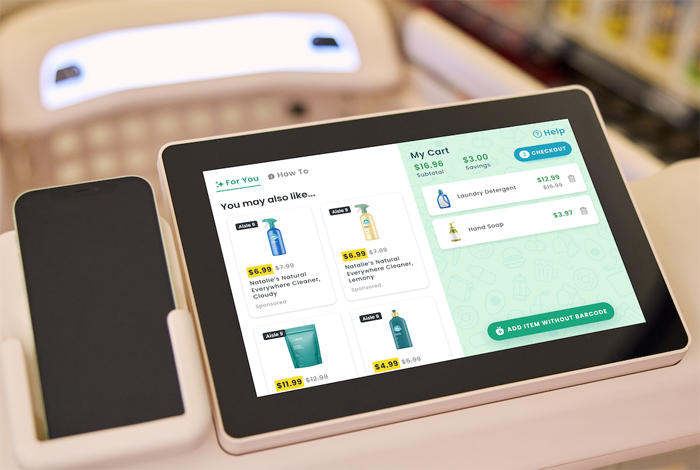Instacart is adding in-store advertising to its cart.
Ahead of CES in Las Vegas on Monday, the company announced plans to expand its ad offerings with Caper Carts, the Instacart-owned shopping carts that scan items for self-checkout. (Instacart acquired the company powering the carts, Caper AI, in 2021.)
In-store advertising on physical smart cart touchscreens is the “next step” for Instacart’s momentum as an ads business, said Ali Miller, VP of product management at Instacart, who spoke with AdExchanger at CES.
Most grocery shopping still happens in person, and advertisers want to get in front of consumers at the very bottom of the funnel – which is to say, while they’re checking off their shopping lists. Initial advertisers buying smart cart ad units include General Mills, Del Monte Foods and the ice cream brand Dreyer’s.
The idea is to have a “high-performing and measurable ad solution,” Miller said, whether people are online or shopping in a store.
Miller said adding in-store shopper targeting opportunities helps brands achieve what is currently a key marketer KPI: incrementality.
Incremental gains
Instacart plans to measure in-store ads similarly to how it approaches online performance: with a focus on incrementality.
But incrementality is an imperfect science. If someone grabs chips off the shelf, how can Instacart determine whether it was because that customer saw an ad on their shopping cart or because chips were already on the grocery list?
It could be downright counterproductive, if someone who was going to make a full-price purchase is given a discount, and the ad tech also gets a cut of what would have been an organic conversion.
“We’ve invested a lot in demonstrating that Instacart does drive [sales] for brands,” Miller said.
After spending years testing sponsored product ads to determine the impact on shopper behavior – such as comparing sales among consumers who did and did not see a particular ad – Instacart pins its average sales lift for sponsored product ads at 15%.
Instacart expects ads on shopping cart screens to have a similar impact on purchase decisions. Caper Carts drives more sales on average compared to basic shopping carts because they helps customers keep track of how much they’re spending, Miller said.
But it will take time to ascertain how much smart cart ad units will actually affect product sales and margins.
First, “we really need to see how these ads perform in the wild,” Miller said. Once ads roll out on smart carts throughout the country, Instacart will be able to recognize patterns in business outcomes.
Incrementality is also Instacart’s preferred remedy for the lack of measurement standards across retail media networks, Miller said.
Once Instacart has a better sense of incremental product sales by retailer, for example, it can help advertisers plan campaigns that are most likely to result in sales.
Would you like an ad with that?
Some retailers already have Caper Carts in stores as of last year, including select locations of Kroger’s, ShopRite and Fairway Market. Instacart declined to confirm an exact number of individual stores with Caper Carts, but says that number should be in the thousands by the end of the year.
Until now, screens on those carts had some general product recommendations based on seasonal or store-specific discounts, but ads weren’t personalized for individual customers, Miller said.
Instacart plans to pilot its shopping cart ads this quarter in Bristol Farms stores, a local grocery chain in California, which makes sense considering Instacart’s focus on wooing smaller and mid-size retailers that don’t have retail media networks or direct advertising businesses.
At first, shopping cart ads will recommend products based on the items people place in their cart (such as, say, suggesting a discount on a hot dog brand when the cart detects hot dog buns), as well as where to find those recommended products.
Eventually, Instacart plans to serve user-targeted ads, such as based on past purchases when customers link their store loyalty accounts to a smart cart, Miller said, although the exact timing is still up in the air.
For now, Miller said, Instacart is on the lookout for the initial impacts of shopping cart ad units on shopper decisions.


















